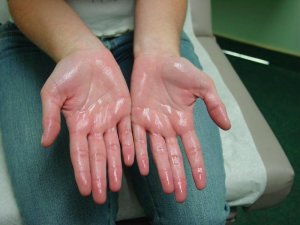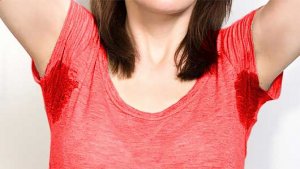

Sweating is a natural method of keeping cool. However, some people develop excess sweating. This can be very debilitating and cause significant social embarrassment. It can be so bad that it affects work. Excess sweating may affect different areas of the body but most commonly affects the hands and armpits.
Hyperhidrosis can be challenging to treat and it may take a while to find the best treatment for you. Less invasive treatments will usually be recommended first.
Initial treatment is with strong antiperspirants such as Anhydrol forte. The benefit of this is usually short lived and the skin can become very irritated.
Oral medications
Anticholinergics :These work by blocking the effects of a chemical called acetylcholine, which the nervous system uses to activate the sweat glands. Anticholinergics are available as tablets or solutions that are applied to affected areas. They’re not widely used to treat hyperhidrosis but some people find them helpful.
Propantheline bromide is an anticholinergic medicine licensed for treating hyperhidrosis. Others such as oxybutynin and glycopyrronium bromide can also be prescribed if your doctor feels they might help.
Possible side effects of anticholinergics include a dry mouth, blurred vision, stomach cramps, constipation and difficulty passing urine.
Due to side effects, oral medications may not be recommended as a long-term solution but they certainly have their place when treating excessive sweating on large parts of the body, when multiple body areas are affected, or as a short-term solution during a special event (such as a presentation at work or an important family function.)
Iontophoresis
Iontophoresis may help if you have excessive sweating that affects your hands or feet. It can also be used to treat armpits, although this is usually less effective.
Iontophoresis involves treating affected areas of skin with a weak electric current passed through water or a wet pad. This is thought to help block the sweat glands.
If your hands and feet need treating, you place them in a bowl of water and a weak electric current is passed through the water. If your armpits need treating, a wet contact pad is placed against each armpit and a current is passed through the pad.
The treatment is not painful but the electric current can cause mild, short-lived discomfort and skin irritation.
Each session of iontophoresis lasts between 20 and 30 minutes, and you will usually need to have two to four sessions a week. Your symptoms should begin to improve after a week or two, after which further treatment will be required at one to four week intervals, depending on how severe your symptoms are.
Iontophoresis is often very effective. You can use a machine such as the Idrostar at home.
Botulinum toxin injections
Botulinum toxin can be injected into the skin in areas of the body affected by hyperhidrosis. This helps reduce sweating in these areas by blocking the signals from the brain to the sweat glands.
A number of superficial injections are given in the affected areas of the body, such as the armpits. The procedure usually takes about 30-45 minutes in total.
The effect of the injections usually lasts for several months, after which time the treatment can be repeated if necessary.
Potential side effects of botulinum toxin injections include:
- pain, redness or itching where the injections are given
- nausea, headaches and hot flushes after the injections are given
- another part of your body sweating more to make up for treated area – known as compensatory sweating
- muscle weakness around the treatment area
Most of these side effects are short-lived or will resolve as the effect of the injections wears off.
Surgery
In a few cases where hyperhidrosis is particularly severe and treatment hasn’t been successful, surgery may be recommended.
Endoscopic thoracic sympathectomy (ETS)
Endoscopic thoracic sympathectomy (ETS) is the most widely used type of surgery to treat hyperhidrosis. It’s usually used in cases affecting the palms or armpits.
Small incisions are made in the side of the chest and the nerves that control sweating in the affected area are cut or clipped. This means signals can no longer pass along them to the sweat glands. The operation is carried out under general anaesthetic and done on both sides of the body.
The National Institute for Health and Care Excellence (NICE) recommends that ETS can be used to treat excessive sweating of the palms or underarms.
Risks and complications of ETS surgery:
- ETS carries a risk of serious complications (see below)
- it’s very common for excessive compensatory sweating to occur after the procedure, which causes some people to regret the procedure
- the procedure is not always successful at reducing sweating
For this reason, only people with severe hyperhidrosis which hasn’t responded to treatment should be considered.
Side effects and complications of ETS can also include:
- sweating of the face and neck after eating food – this is known as gustatory sweating and may affect up to half of people who have the procedure
- bleeding into the chest during surgery
- air becoming trapped inside the chest (pneumothorax), which can cause chest pain and breathing difficulties
- damage to the nervous system that causes the upper eyelid on one side of the body to droop (Horner’s syndrome) – this may be permanent
If you wish to discuss any of these treatments, please make an appointment to see me.